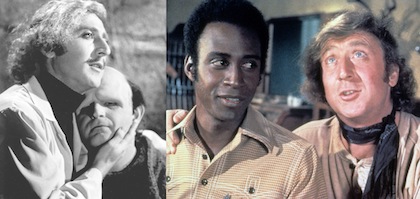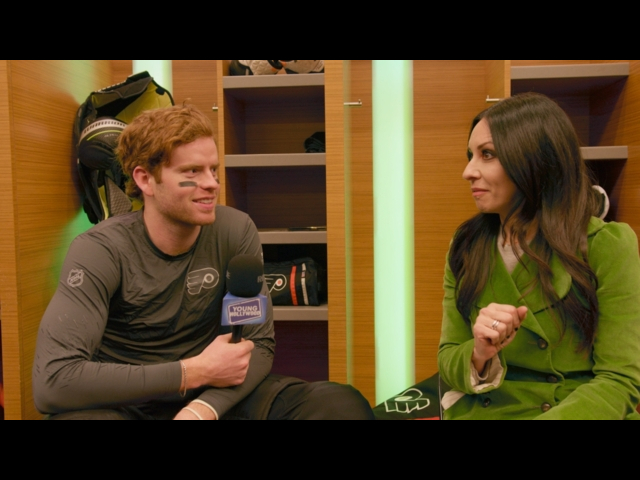'Blazing Saddles' & 'Young Frankenstein' Turn 40: Fun Facts from 2 Mel Brooks Classics!

This year marks the 40th anniversary of two classic comedies, Blazing Saddles (released February 7, 1974) and Young Frankenstein (released December 10, 1974). Aside from both starring Gene Wilder, these films have one other important thing in common: they were both written and directed by comedy king Mel Brooks. This marked an unprecedented year not just for comedy but the film industry in general. It’s one thing for somebody to star in a couple of hit movies in one year, but it’s completely another to head the production of two smash hits in the same year. Being armed with small budgets of just over $2 million for each may have helped Brooks accomplish this, but in any case, this is a feat that has not been duplicated since.
In honor of these 2 game-changing films turning the big 4-0 this year, here are some facts you may not have known about each movie!
Blazing Saddles
- It’s the first movie to ever feature the sound of farting. According to Brooks, the now-famous farting scene came from watching westerns where cowboys were drinking black coffee and eating beans. Brooks, like many of us, couldn’t believe these cowboys could do all this without constantly farting. (This is my favorite fact.) Brooks acquired the farting noises by asking any stranger he could to rub their hands with soap and then use it to make the noise with their armpits. I honestly want to meet the people he convinced to do this and get their side of the story.
- Warner Bros. almost never released Blazing Saddles. During one of the first screenings for the studio executives, it was so quiet that if somebody actually did fart, it would have echoed. Brooks immediately set up a screening for regular Warner Bros. employees (people like you and me), and when they filled the screening with laughter, Warner Bros. decided to release the film.
- Mel Brooks wasn’t the sole writer. In fact, there were five different writers, one of which was fellow comedy legend Richard Pryor.
- Speaking of Pryor, he was Brooks’s first choice to play the lead character of Sheriff Bart. At this time, Richard Pryor was an infamous figure in the entertainment business, and Warner Bros. refused to have him. Brooks fought them just like Lorne Michaels did when NBC rejected the idea of having Richard Pryor host an episode of "SNL". Unlike Lorne Michaels, though, Brooks’s pleas fell on deaf ears. The decidedly uncontroversial Cleavon Little was cast instead, and Mel Brooks has expressed complete admiration for him ever since.
- Frankie Laine, the singer of the sweeping theme song, was lead to believe he was singing the song for a dramatic western and not a comedy. Mel Brooks was nervous that if Laine had known it was a comedy, he wouldn’t sing the song with as much conviction.
- Blazing Saddles mentions Raisinets once. Mel Brooks now receives a gross amount of Raisinets every month.
- Brooks plays three different roles in the film: the lustful and dumbfounded Governor William J. Le Petomane, a Jewish Indian Chief in a flashback of Bart’s childhood; and a German pilot waiting to sign up for Hedley Lamarr's posse (which went uncredited).
- When writing the movie, Brooks and his staff ate lunch across from John Wayne. Word had gotten to The Duke about a western where people say “Blow it out your ass.” He expressed interest in getting a role in the movie to Brooks, who then gave Wayne a copy of the script. But when the legend finished it, he said, “Naw, I can’t do a movie like that, but I’ll be first in line to see it.”
- A famous scene in which the cast breaks the fourth wall and runs rampant throughout Warner Bros. Studios, includes a person not a part of the cast. He just seemed to not really understand what was going on and wouldn’t leave set. Mel Brooks himself speak about it here (he also sneaks in another fact for you).
- On set, Gene Wilder pitched another movie idea to Mel. Brooks became very interested in it and got to writing, which now brings us to…
Young Frankenstein
- The original cut of the film was over three hours. This cut was considered horrendous by all involved, so Gene Wilder (who plays Dr. Frederick Frankenstein) and Mel Brooks got to cutting it down as quickly as they could. They have both stated that, for every joke that worked, there were three that failed horribly. The final cut is the one we all know and love today.
- A lot of this movie was improvised, but one of the actions on screen took time for the cast and crew to recognize. Marty Feldman (Igor) switched his hump around in between shots for several days before someone on set finally realized what he was doing.
- One of Mel Brooks’s cameos is also improvised. In a scene where Gene Wilder accidently throws a dart out a window a cat screams in agony. Brooks himself makes the noise and came up with it on the spot. Mel also provides the voice of a howling wolf and of the original Dr. Frankenstein himself.
- When Frederick and Inga (played by Teri Garr) are exploring the hidden laboratory, the skulls they walk by are all real expect for the one labeled “Six Months Dead”.
- Mel Brooks thought the “walk this way” gag was too corny and didn’t want it in the film. After seeing audiences’ positive reactions after one of the first screenings, though, he decided to keep it in. It also inspired one of Aerosmith’s hits, “Walk This Way”, which they calm to have written the morning after seeing the film.
- The entire cast, and Brooks himself, were so bummed that principal shooting was over that Brooks added in extra scenes to continue shooting.
- On the DVD commentary of the television show "Get Smart", Brooks explained that Columbia Pictures denied his request to shoot in black-and-white. Upon this disappointment, he took the film to Twentieth Century Fox, and they agreed to give him complete creative control over the film with the caveat that Brooks and Wilder would sign a five-year contract. To further maintain tradition, Brooks employed similar black-and-white introductory credits and ending titles similar to those in the original 1931 film. Both of these aspects were unseen in the films of the 1970s, as almost everything was by that time being shot in color.
- When Frederick takes a train from the USA. to Germany (yeah, they did that), the couple speaking in English have the same conversation in German when we switch countries.
- The scene that took longest to shoot is in the video below. It was hard to get a take where nobody was laughing. Pay attention to Gene Wilder because he actually doesn’t quite manage to keep himself composed:
There you have it, some facts about two great movies that are turning 40 this year. If you have never seen them, then what’re you doing reading this? Go and buy them right now!
(Photos via WENN)
- Kevin Donaldson, YH Staff



